Project Charter Assignment PDF
VerifiedAdded on 2021/05/31
|18
|2373
|465
AI Summary
Contribute Materials
Your contribution can guide someone’s learning journey. Share your
documents today.
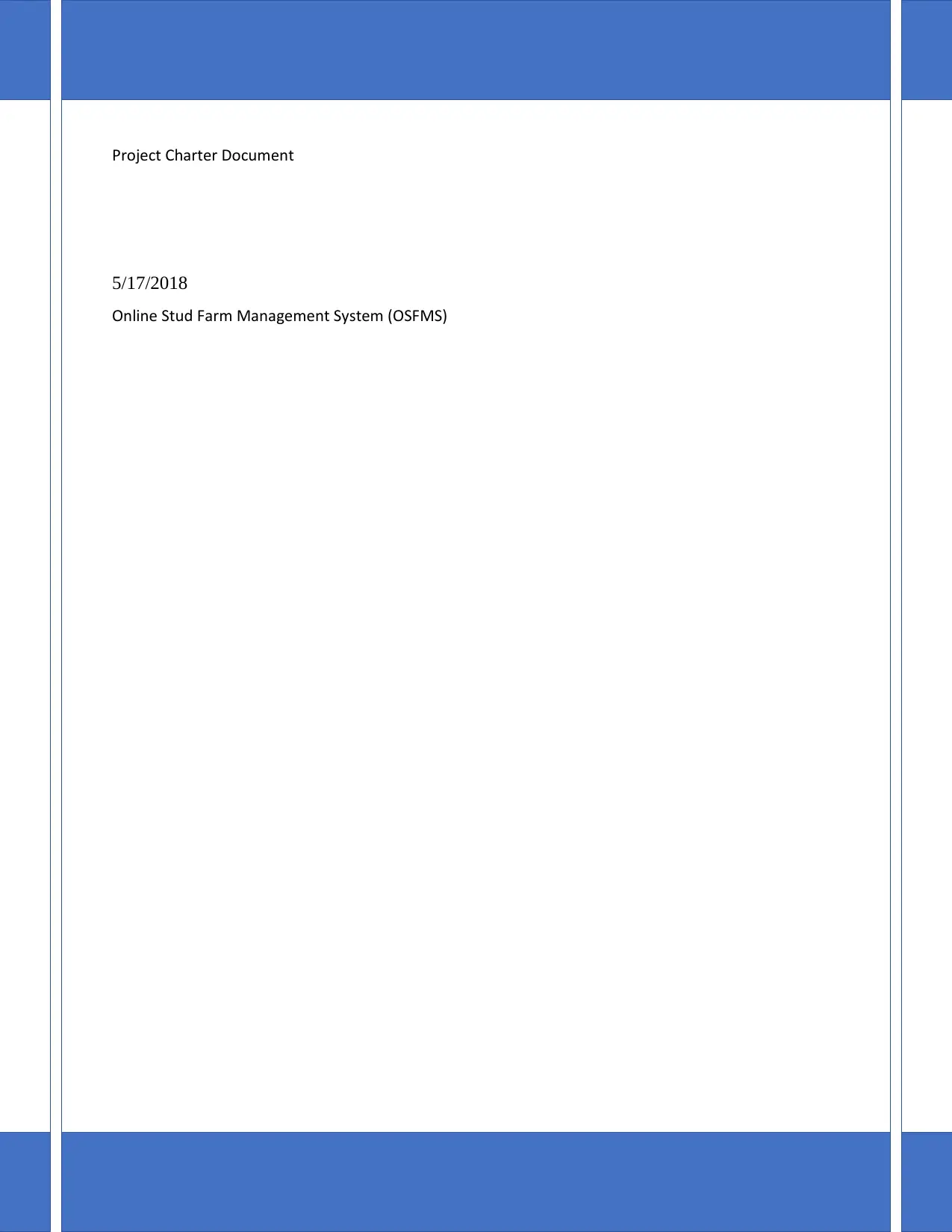
Project Charter Document
5/17/2018
Online Stud Farm Management System (OSFMS)
5/17/2018
Online Stud Farm Management System (OSFMS)
Secure Best Marks with AI Grader
Need help grading? Try our AI Grader for instant feedback on your assignments.
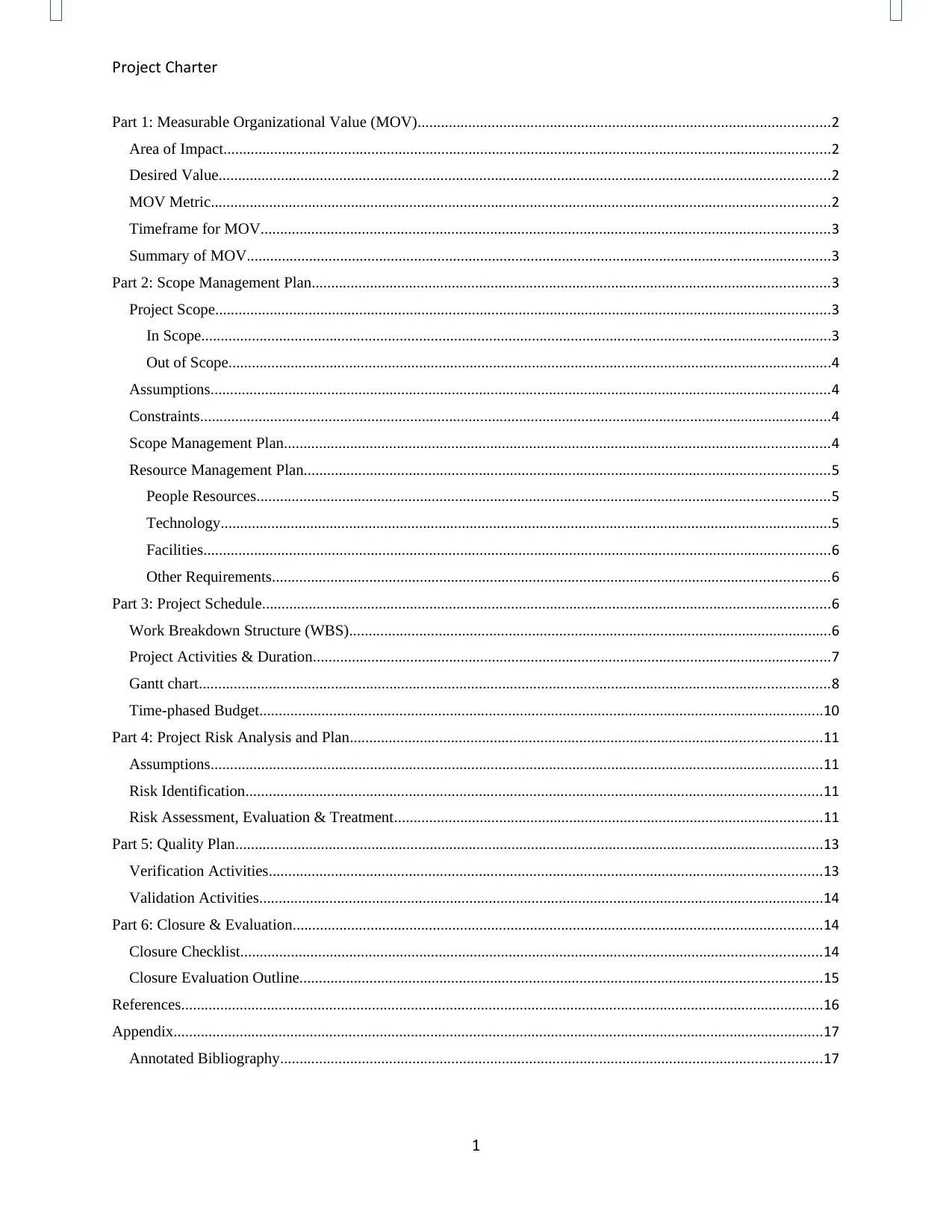
Project Charter
Part 1: Measurable Organizational Value (MOV)..........................................................................................................2
Area of Impact............................................................................................................................................................2
Desired Value.............................................................................................................................................................2
MOV Metric...............................................................................................................................................................2
Timeframe for MOV..................................................................................................................................................3
Summary of MOV......................................................................................................................................................3
Part 2: Scope Management Plan.....................................................................................................................................3
Project Scope..............................................................................................................................................................3
In Scope..................................................................................................................................................................3
Out of Scope...........................................................................................................................................................4
Assumptions...............................................................................................................................................................4
Constraints..................................................................................................................................................................4
Scope Management Plan............................................................................................................................................4
Resource Management Plan.......................................................................................................................................5
People Resources...................................................................................................................................................5
Technology.............................................................................................................................................................5
Facilities.................................................................................................................................................................6
Other Requirements...............................................................................................................................................6
Part 3: Project Schedule..................................................................................................................................................6
Work Breakdown Structure (WBS)............................................................................................................................6
Project Activities & Duration.....................................................................................................................................7
Gantt chart..................................................................................................................................................................8
Time-phased Budget.................................................................................................................................................10
Part 4: Project Risk Analysis and Plan.........................................................................................................................11
Assumptions.............................................................................................................................................................11
Risk Identification....................................................................................................................................................11
Risk Assessment, Evaluation & Treatment..............................................................................................................11
Part 5: Quality Plan.......................................................................................................................................................13
Verification Activities..............................................................................................................................................13
Validation Activities.................................................................................................................................................14
Part 6: Closure & Evaluation........................................................................................................................................14
Closure Checklist.....................................................................................................................................................14
Closure Evaluation Outline......................................................................................................................................15
References.....................................................................................................................................................................16
Appendix.......................................................................................................................................................................17
Annotated Bibliography...........................................................................................................................................17
1
Part 1: Measurable Organizational Value (MOV)..........................................................................................................2
Area of Impact............................................................................................................................................................2
Desired Value.............................................................................................................................................................2
MOV Metric...............................................................................................................................................................2
Timeframe for MOV..................................................................................................................................................3
Summary of MOV......................................................................................................................................................3
Part 2: Scope Management Plan.....................................................................................................................................3
Project Scope..............................................................................................................................................................3
In Scope..................................................................................................................................................................3
Out of Scope...........................................................................................................................................................4
Assumptions...............................................................................................................................................................4
Constraints..................................................................................................................................................................4
Scope Management Plan............................................................................................................................................4
Resource Management Plan.......................................................................................................................................5
People Resources...................................................................................................................................................5
Technology.............................................................................................................................................................5
Facilities.................................................................................................................................................................6
Other Requirements...............................................................................................................................................6
Part 3: Project Schedule..................................................................................................................................................6
Work Breakdown Structure (WBS)............................................................................................................................6
Project Activities & Duration.....................................................................................................................................7
Gantt chart..................................................................................................................................................................8
Time-phased Budget.................................................................................................................................................10
Part 4: Project Risk Analysis and Plan.........................................................................................................................11
Assumptions.............................................................................................................................................................11
Risk Identification....................................................................................................................................................11
Risk Assessment, Evaluation & Treatment..............................................................................................................11
Part 5: Quality Plan.......................................................................................................................................................13
Verification Activities..............................................................................................................................................13
Validation Activities.................................................................................................................................................14
Part 6: Closure & Evaluation........................................................................................................................................14
Closure Checklist.....................................................................................................................................................14
Closure Evaluation Outline......................................................................................................................................15
References.....................................................................................................................................................................16
Appendix.......................................................................................................................................................................17
Annotated Bibliography...........................................................................................................................................17
1
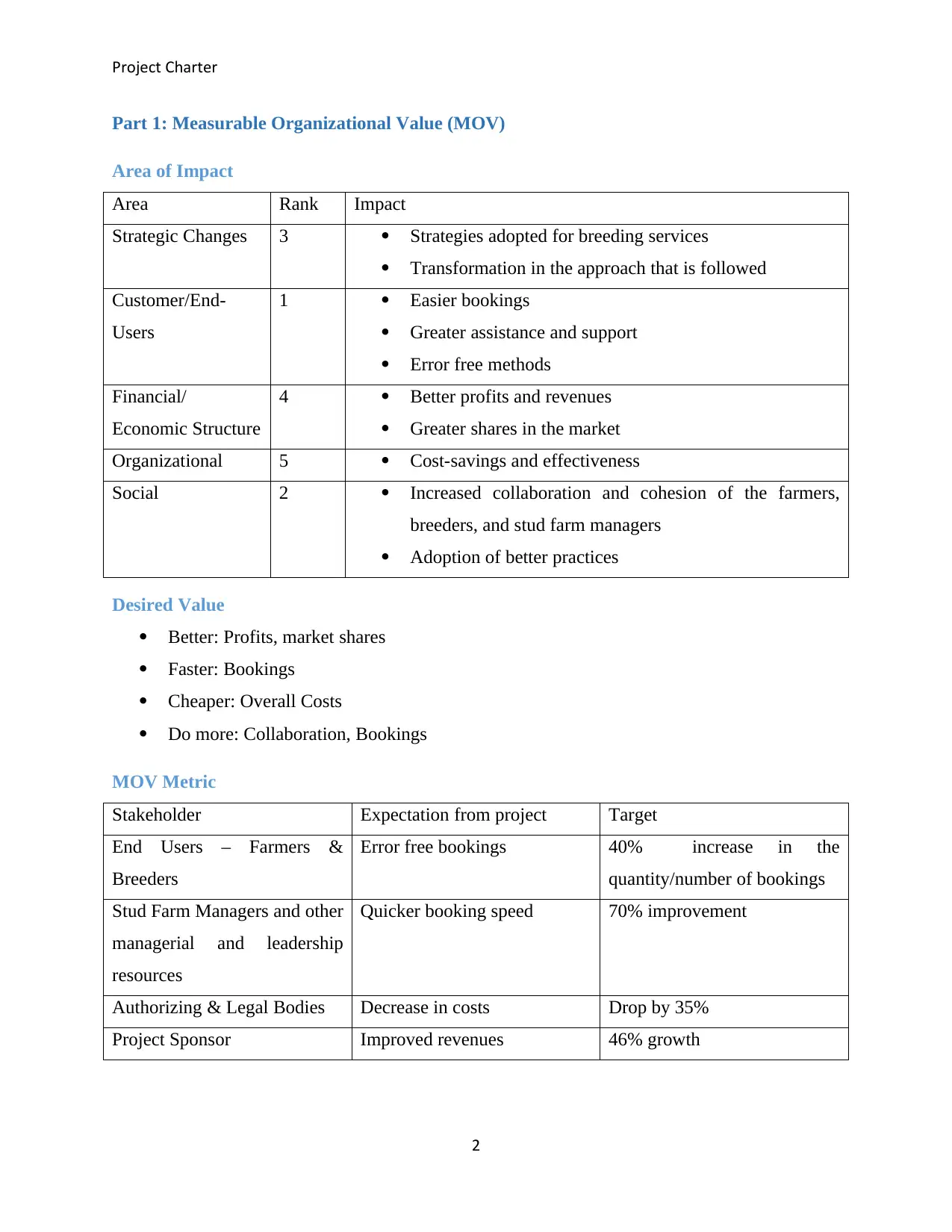
Project Charter
Part 1: Measurable Organizational Value (MOV)
Area of Impact
Area Rank Impact
Strategic Changes 3 Strategies adopted for breeding services
Transformation in the approach that is followed
Customer/End-
Users
1 Easier bookings
Greater assistance and support
Error free methods
Financial/
Economic Structure
4 Better profits and revenues
Greater shares in the market
Organizational 5 Cost-savings and effectiveness
Social 2 Increased collaboration and cohesion of the farmers,
breeders, and stud farm managers
Adoption of better practices
Desired Value
Better: Profits, market shares
Faster: Bookings
Cheaper: Overall Costs
Do more: Collaboration, Bookings
MOV Metric
Stakeholder Expectation from project Target
End Users – Farmers &
Breeders
Error free bookings 40% increase in the
quantity/number of bookings
Stud Farm Managers and other
managerial and leadership
resources
Quicker booking speed 70% improvement
Authorizing & Legal Bodies Decrease in costs Drop by 35%
Project Sponsor Improved revenues 46% growth
2
Part 1: Measurable Organizational Value (MOV)
Area of Impact
Area Rank Impact
Strategic Changes 3 Strategies adopted for breeding services
Transformation in the approach that is followed
Customer/End-
Users
1 Easier bookings
Greater assistance and support
Error free methods
Financial/
Economic Structure
4 Better profits and revenues
Greater shares in the market
Organizational 5 Cost-savings and effectiveness
Social 2 Increased collaboration and cohesion of the farmers,
breeders, and stud farm managers
Adoption of better practices
Desired Value
Better: Profits, market shares
Faster: Bookings
Cheaper: Overall Costs
Do more: Collaboration, Bookings
MOV Metric
Stakeholder Expectation from project Target
End Users – Farmers &
Breeders
Error free bookings 40% increase in the
quantity/number of bookings
Stud Farm Managers and other
managerial and leadership
resources
Quicker booking speed 70% improvement
Authorizing & Legal Bodies Decrease in costs Drop by 35%
Project Sponsor Improved revenues 46% growth
2
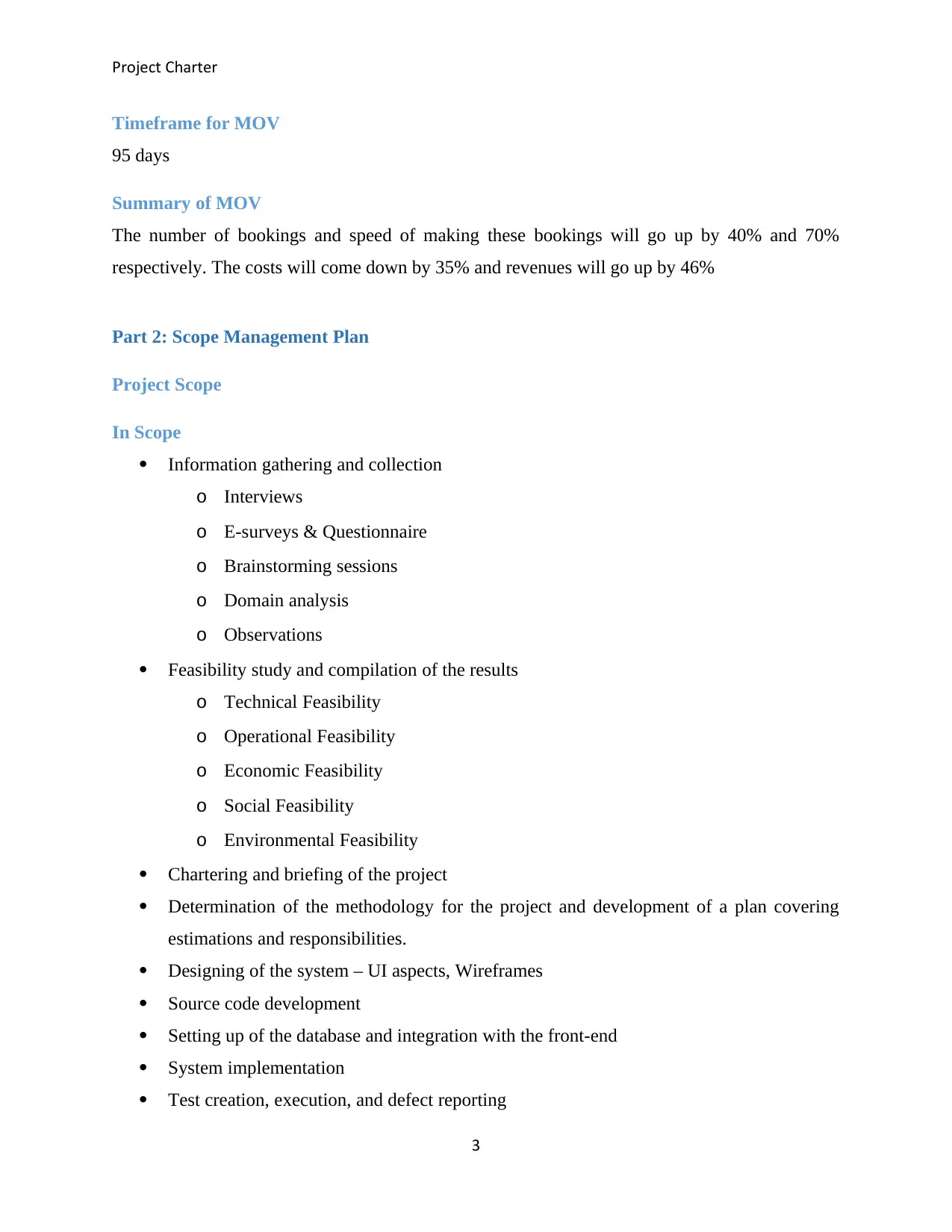
Project Charter
Timeframe for MOV
95 days
Summary of MOV
The number of bookings and speed of making these bookings will go up by 40% and 70%
respectively. The costs will come down by 35% and revenues will go up by 46%
Part 2: Scope Management Plan
Project Scope
In Scope
Information gathering and collection
o Interviews
o E-surveys & Questionnaire
o Brainstorming sessions
o Domain analysis
o Observations
Feasibility study and compilation of the results
o Technical Feasibility
o Operational Feasibility
o Economic Feasibility
o Social Feasibility
o Environmental Feasibility
Chartering and briefing of the project
Determination of the methodology for the project and development of a plan covering
estimations and responsibilities.
Designing of the system – UI aspects, Wireframes
Source code development
Setting up of the database and integration with the front-end
System implementation
Test creation, execution, and defect reporting
3
Timeframe for MOV
95 days
Summary of MOV
The number of bookings and speed of making these bookings will go up by 40% and 70%
respectively. The costs will come down by 35% and revenues will go up by 46%
Part 2: Scope Management Plan
Project Scope
In Scope
Information gathering and collection
o Interviews
o E-surveys & Questionnaire
o Brainstorming sessions
o Domain analysis
o Observations
Feasibility study and compilation of the results
o Technical Feasibility
o Operational Feasibility
o Economic Feasibility
o Social Feasibility
o Environmental Feasibility
Chartering and briefing of the project
Determination of the methodology for the project and development of a plan covering
estimations and responsibilities.
Designing of the system – UI aspects, Wireframes
Source code development
Setting up of the database and integration with the front-end
System implementation
Test creation, execution, and defect reporting
3
Secure Best Marks with AI Grader
Need help grading? Try our AI Grader for instant feedback on your assignments.
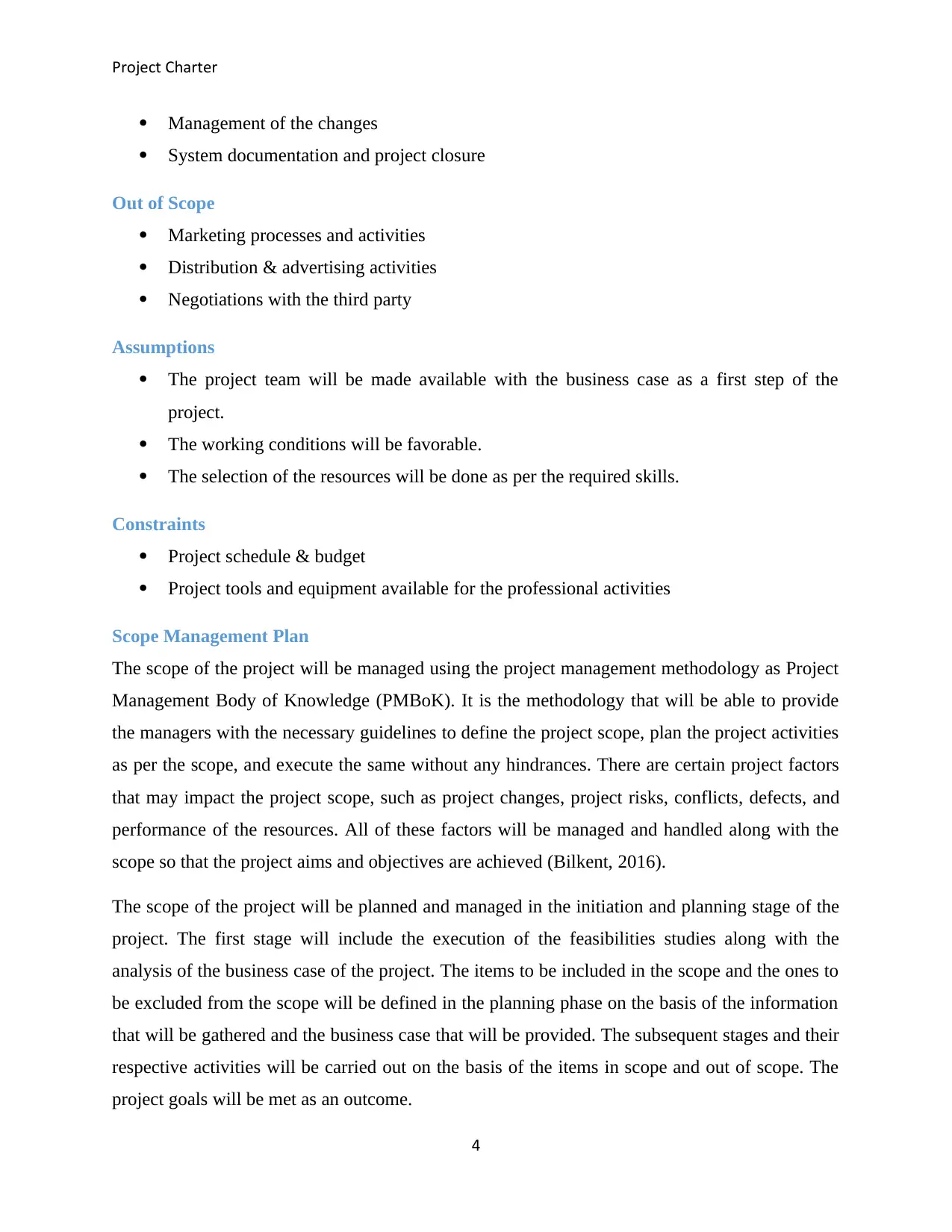
Project Charter
Management of the changes
System documentation and project closure
Out of Scope
Marketing processes and activities
Distribution & advertising activities
Negotiations with the third party
Assumptions
The project team will be made available with the business case as a first step of the
project.
The working conditions will be favorable.
The selection of the resources will be done as per the required skills.
Constraints
Project schedule & budget
Project tools and equipment available for the professional activities
Scope Management Plan
The scope of the project will be managed using the project management methodology as Project
Management Body of Knowledge (PMBoK). It is the methodology that will be able to provide
the managers with the necessary guidelines to define the project scope, plan the project activities
as per the scope, and execute the same without any hindrances. There are certain project factors
that may impact the project scope, such as project changes, project risks, conflicts, defects, and
performance of the resources. All of these factors will be managed and handled along with the
scope so that the project aims and objectives are achieved (Bilkent, 2016).
The scope of the project will be planned and managed in the initiation and planning stage of the
project. The first stage will include the execution of the feasibilities studies along with the
analysis of the business case of the project. The items to be included in the scope and the ones to
be excluded from the scope will be defined in the planning phase on the basis of the information
that will be gathered and the business case that will be provided. The subsequent stages and their
respective activities will be carried out on the basis of the items in scope and out of scope. The
project goals will be met as an outcome.
4
Management of the changes
System documentation and project closure
Out of Scope
Marketing processes and activities
Distribution & advertising activities
Negotiations with the third party
Assumptions
The project team will be made available with the business case as a first step of the
project.
The working conditions will be favorable.
The selection of the resources will be done as per the required skills.
Constraints
Project schedule & budget
Project tools and equipment available for the professional activities
Scope Management Plan
The scope of the project will be managed using the project management methodology as Project
Management Body of Knowledge (PMBoK). It is the methodology that will be able to provide
the managers with the necessary guidelines to define the project scope, plan the project activities
as per the scope, and execute the same without any hindrances. There are certain project factors
that may impact the project scope, such as project changes, project risks, conflicts, defects, and
performance of the resources. All of these factors will be managed and handled along with the
scope so that the project aims and objectives are achieved (Bilkent, 2016).
The scope of the project will be planned and managed in the initiation and planning stage of the
project. The first stage will include the execution of the feasibilities studies along with the
analysis of the business case of the project. The items to be included in the scope and the ones to
be excluded from the scope will be defined in the planning phase on the basis of the information
that will be gathered and the business case that will be provided. The subsequent stages and their
respective activities will be carried out on the basis of the items in scope and out of scope. The
project goals will be met as an outcome.
4
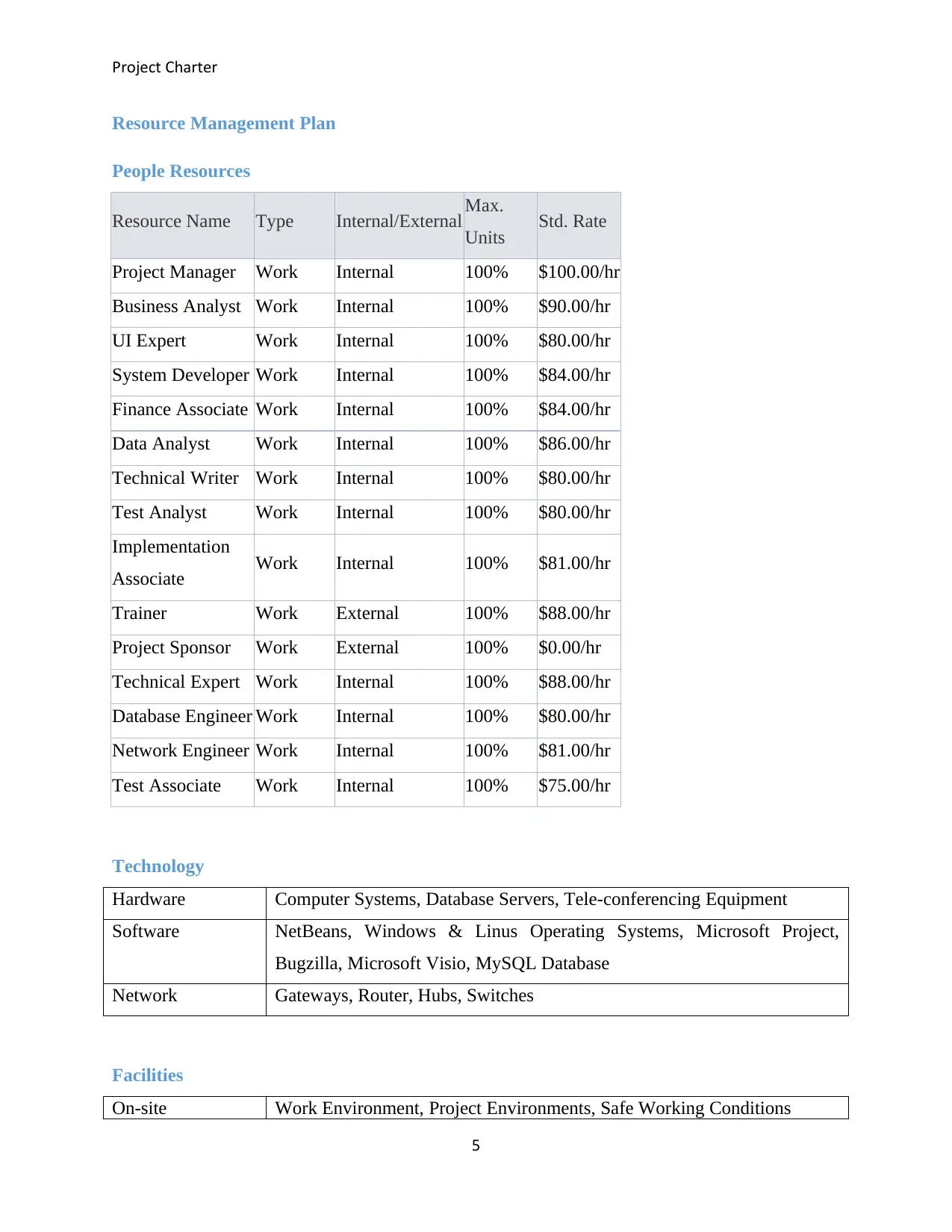
Project Charter
Resource Management Plan
People Resources
Resource Name Type Internal/External Max.
Units Std. Rate
Project Manager Work Internal 100% $100.00/hr
Business Analyst Work Internal 100% $90.00/hr
UI Expert Work Internal 100% $80.00/hr
System Developer Work Internal 100% $84.00/hr
Finance Associate Work Internal 100% $84.00/hr
Data Analyst Work Internal 100% $86.00/hr
Technical Writer Work Internal 100% $80.00/hr
Test Analyst Work Internal 100% $80.00/hr
Implementation
Associate Work Internal 100% $81.00/hr
Trainer Work External 100% $88.00/hr
Project Sponsor Work External 100% $0.00/hr
Technical Expert Work Internal 100% $88.00/hr
Database Engineer Work Internal 100% $80.00/hr
Network Engineer Work Internal 100% $81.00/hr
Test Associate Work Internal 100% $75.00/hr
Technology
Hardware Computer Systems, Database Servers, Tele-conferencing Equipment
Software NetBeans, Windows & Linus Operating Systems, Microsoft Project,
Bugzilla, Microsoft Visio, MySQL Database
Network Gateways, Router, Hubs, Switches
Facilities
On-site Work Environment, Project Environments, Safe Working Conditions
5
Resource Management Plan
People Resources
Resource Name Type Internal/External Max.
Units Std. Rate
Project Manager Work Internal 100% $100.00/hr
Business Analyst Work Internal 100% $90.00/hr
UI Expert Work Internal 100% $80.00/hr
System Developer Work Internal 100% $84.00/hr
Finance Associate Work Internal 100% $84.00/hr
Data Analyst Work Internal 100% $86.00/hr
Technical Writer Work Internal 100% $80.00/hr
Test Analyst Work Internal 100% $80.00/hr
Implementation
Associate Work Internal 100% $81.00/hr
Trainer Work External 100% $88.00/hr
Project Sponsor Work External 100% $0.00/hr
Technical Expert Work Internal 100% $88.00/hr
Database Engineer Work Internal 100% $80.00/hr
Network Engineer Work Internal 100% $81.00/hr
Test Associate Work Internal 100% $75.00/hr
Technology
Hardware Computer Systems, Database Servers, Tele-conferencing Equipment
Software NetBeans, Windows & Linus Operating Systems, Microsoft Project,
Bugzilla, Microsoft Visio, MySQL Database
Network Gateways, Router, Hubs, Switches
Facilities
On-site Work Environment, Project Environments, Safe Working Conditions
5

Project Charter
Other Requirements
Training schedule and plan for the resources
Conduction of training
Part 3: Project Schedule
Work Breakdown Structure (WBS)
6
Online Stud Farm
Management
System
Start-up Stage
Analysis of
Feasibility
Briefing &
Chartering
Submission of Brief
& Charter
Approval on the
Charter of the
Project
Kick-off Meeting
Milestone 1:
Project Charter
Document
Planning Stage
Definition of
OSFMS Scope
Analysis &
Evaluation of Risks,
Risk Management
Plan
Time-phased
Project Budget
Schedule
Estimation
Communication
Planning
Allocation of Duties
to the Resources
Milestone 2:
Project Plan
Execution Stage
Data and
Requirements
Analysis
Tools & Equipment
Procurement
Development, Test,
& Production
Environment Set-
up
System Designing -
UI & Wireframes
Coding of the
OSFMS
Database
Integration
Milestone 3:
Source Code
Monitoring &
Control Stage
Testing Processes &
Defect Reporting
Change Requests
Approval & Change
Management
System
Implementation
Reviews & Audits
Mielstone 4:
Review Report
Project Closure
Training to the End
Users
System
Documentation &
Manuals
Formal Acceptance
on the Deliverables
Archiving of the
files
Reflection Tasks
Milestone 5:
Project Completion
Report
Other Requirements
Training schedule and plan for the resources
Conduction of training
Part 3: Project Schedule
Work Breakdown Structure (WBS)
6
Online Stud Farm
Management
System
Start-up Stage
Analysis of
Feasibility
Briefing &
Chartering
Submission of Brief
& Charter
Approval on the
Charter of the
Project
Kick-off Meeting
Milestone 1:
Project Charter
Document
Planning Stage
Definition of
OSFMS Scope
Analysis &
Evaluation of Risks,
Risk Management
Plan
Time-phased
Project Budget
Schedule
Estimation
Communication
Planning
Allocation of Duties
to the Resources
Milestone 2:
Project Plan
Execution Stage
Data and
Requirements
Analysis
Tools & Equipment
Procurement
Development, Test,
& Production
Environment Set-
up
System Designing -
UI & Wireframes
Coding of the
OSFMS
Database
Integration
Milestone 3:
Source Code
Monitoring &
Control Stage
Testing Processes &
Defect Reporting
Change Requests
Approval & Change
Management
System
Implementation
Reviews & Audits
Mielstone 4:
Review Report
Project Closure
Training to the End
Users
System
Documentation &
Manuals
Formal Acceptance
on the Deliverables
Archiving of the
files
Reflection Tasks
Milestone 5:
Project Completion
Report
Paraphrase This Document
Need a fresh take? Get an instant paraphrase of this document with our AI Paraphraser
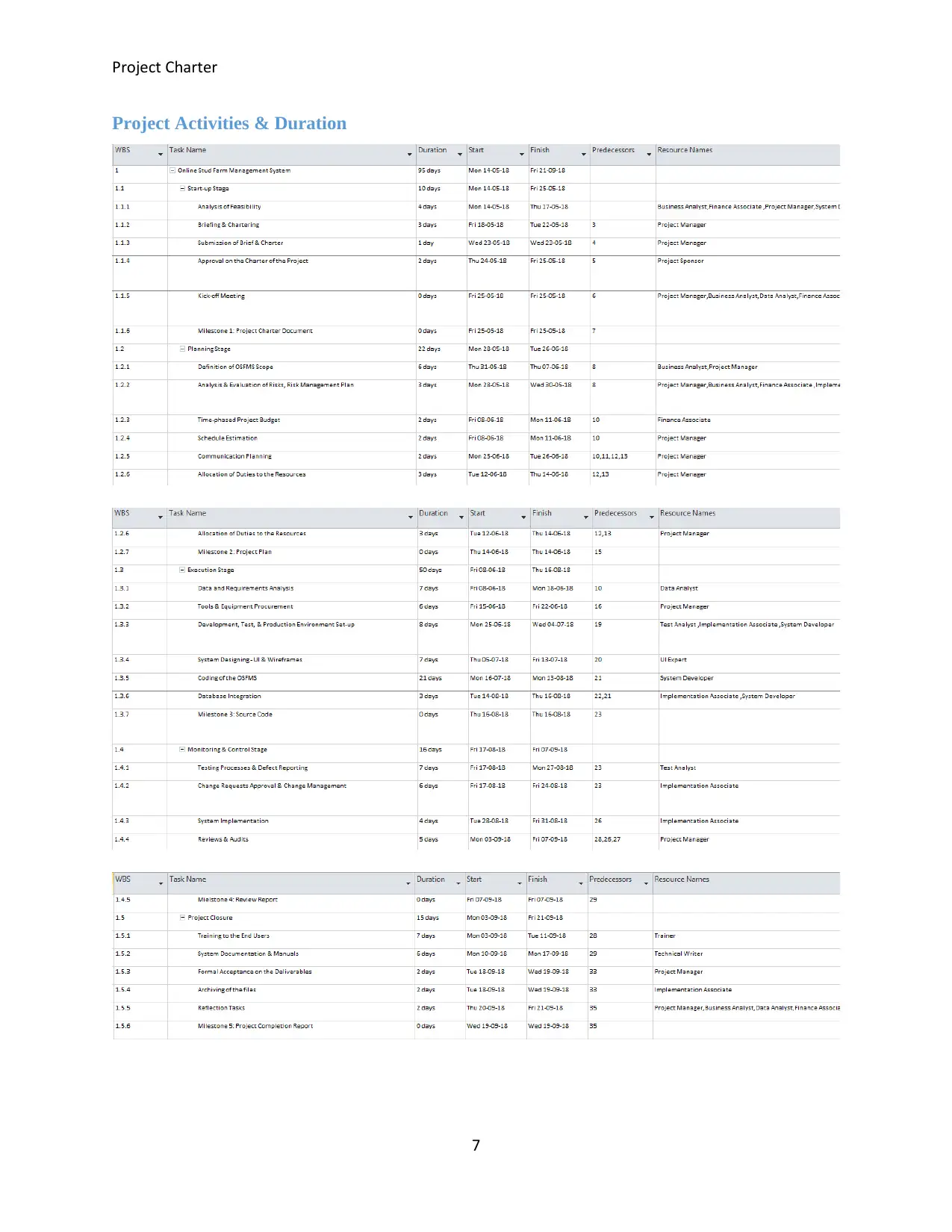
Project Charter
Project Activities & Duration
7
Project Activities & Duration
7
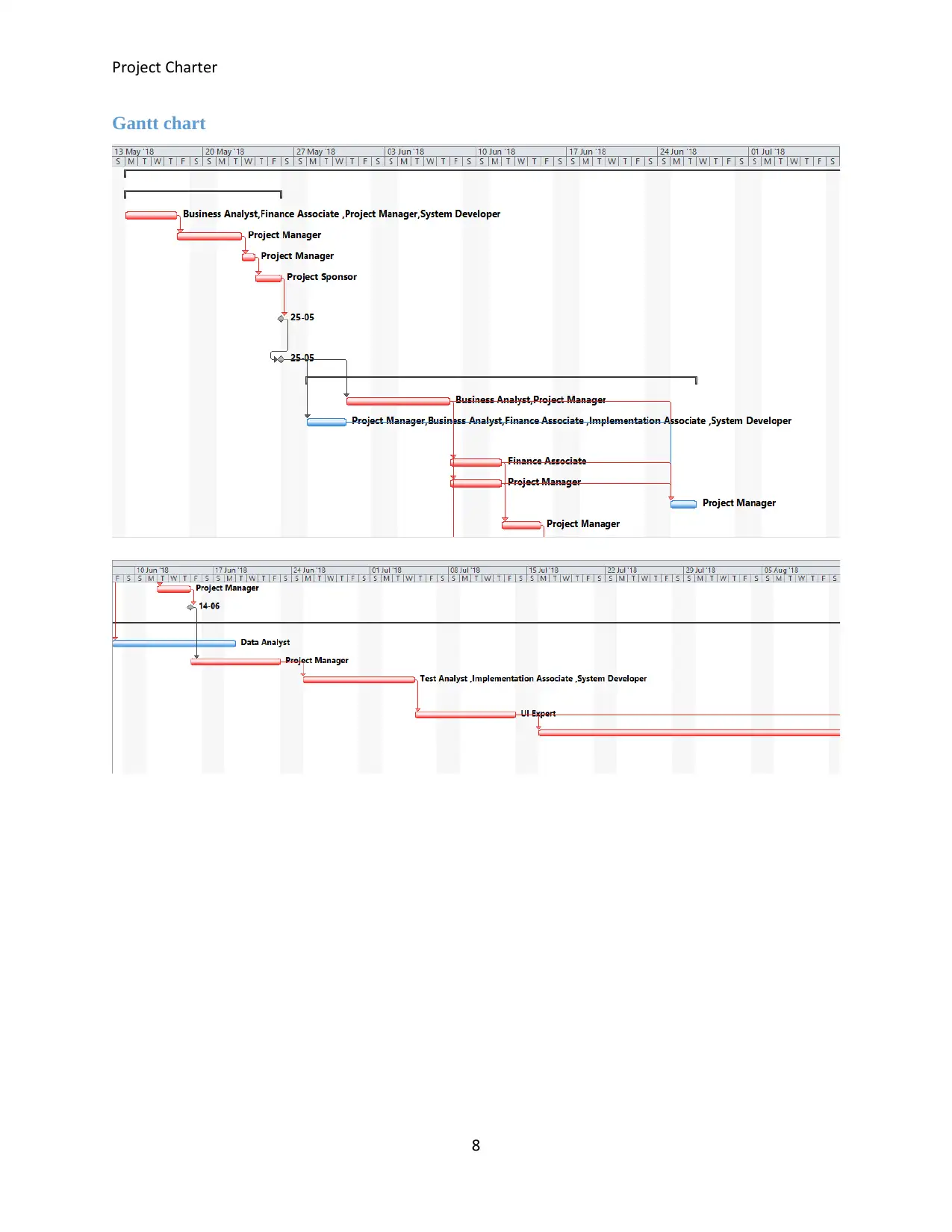
Project Charter
Gantt chart
8
Gantt chart
8
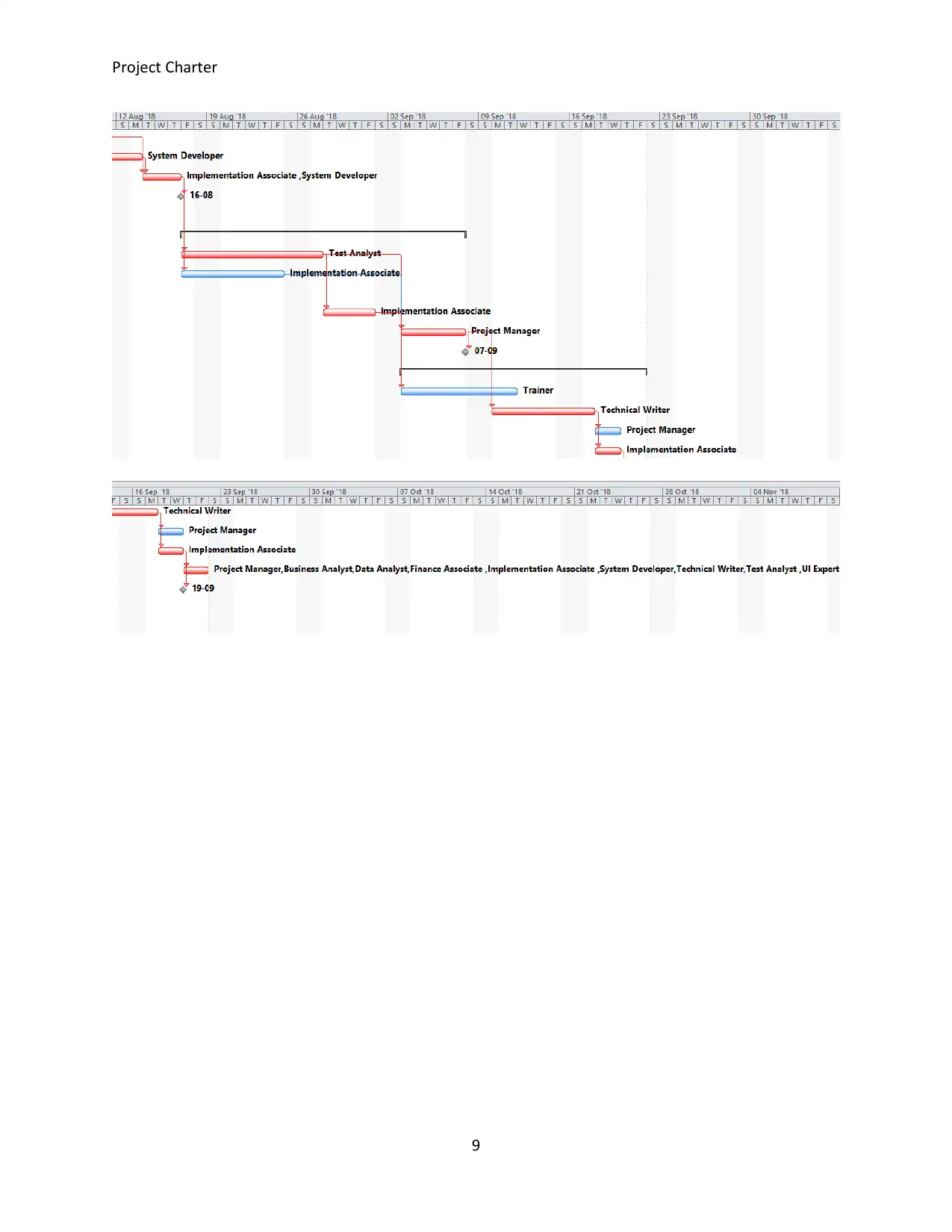
Project Charter
9
9
Secure Best Marks with AI Grader
Need help grading? Try our AI Grader for instant feedback on your assignments.
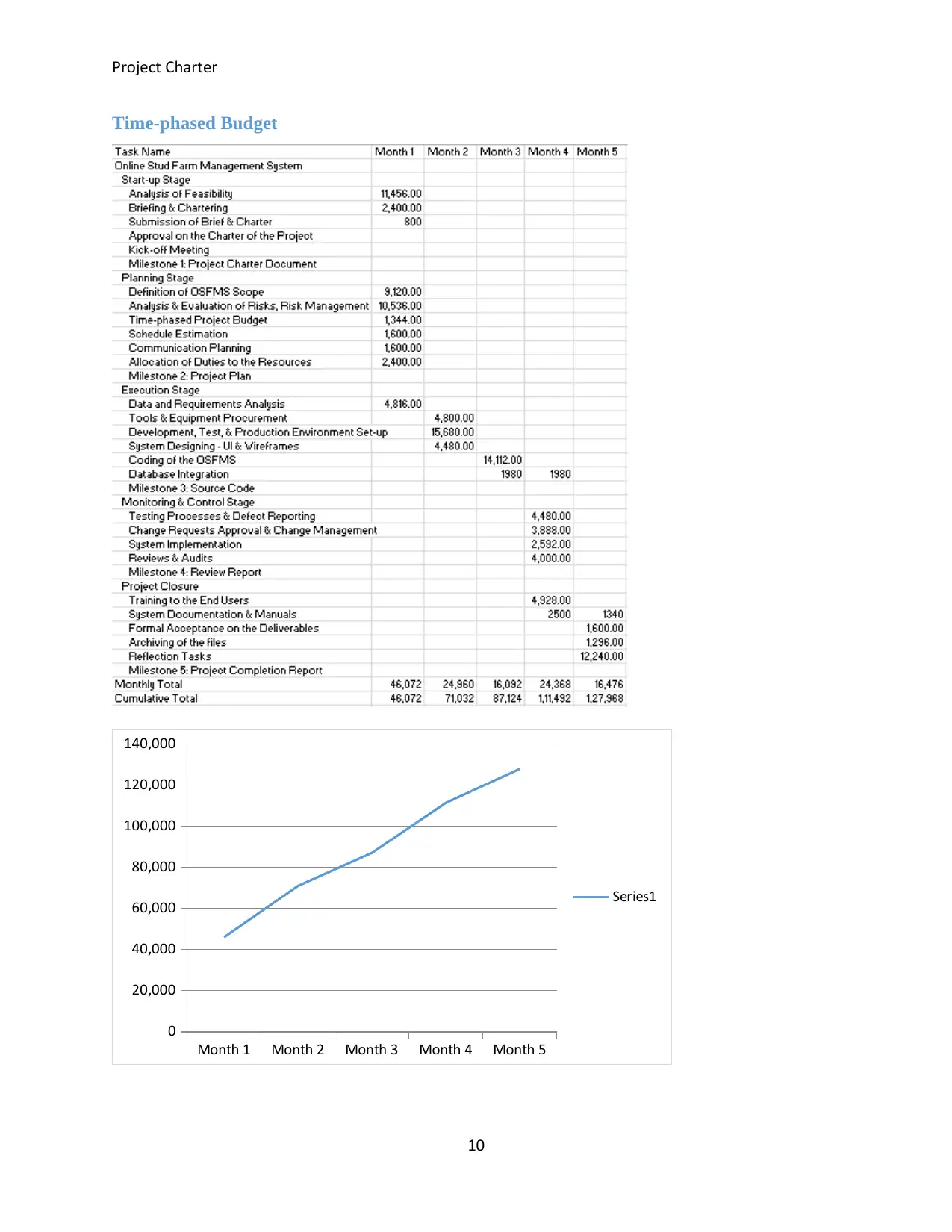
Project Charter
Time-phased Budget
Month 1 Month 2 Month 3 Month 4 Month 5
0
20,000
40,000
60,000
80,000
100,000
120,000
140,000
Series1
10
Time-phased Budget
Month 1 Month 2 Month 3 Month 4 Month 5
0
20,000
40,000
60,000
80,000
100,000
120,000
140,000
Series1
10
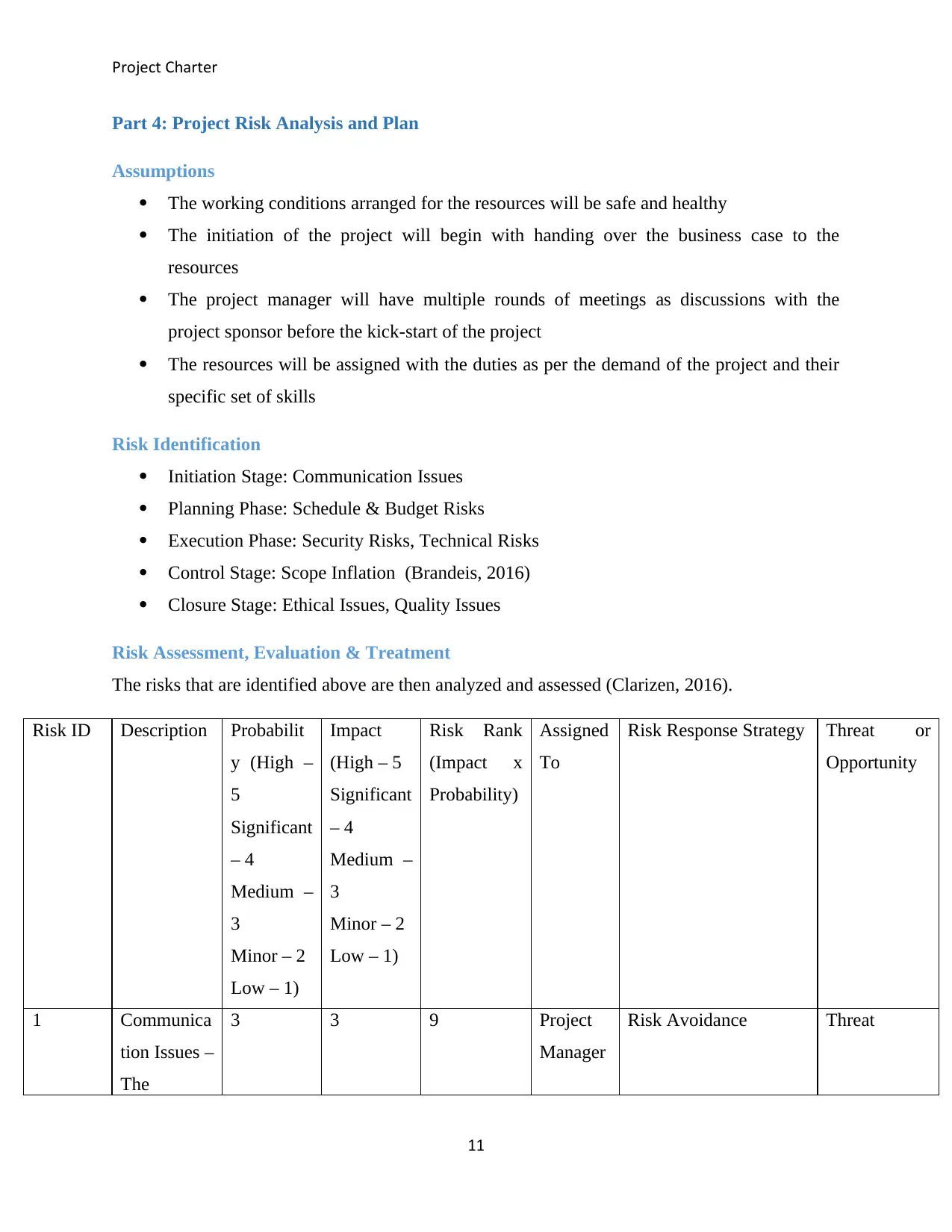
Project Charter
Part 4: Project Risk Analysis and Plan
Assumptions
The working conditions arranged for the resources will be safe and healthy
The initiation of the project will begin with handing over the business case to the
resources
The project manager will have multiple rounds of meetings as discussions with the
project sponsor before the kick-start of the project
The resources will be assigned with the duties as per the demand of the project and their
specific set of skills
Risk Identification
Initiation Stage: Communication Issues
Planning Phase: Schedule & Budget Risks
Execution Phase: Security Risks, Technical Risks
Control Stage: Scope Inflation (Brandeis, 2016)
Closure Stage: Ethical Issues, Quality Issues
Risk Assessment, Evaluation & Treatment
The risks that are identified above are then analyzed and assessed (Clarizen, 2016).
Risk ID Description Probabilit
y (High –
5
Significant
– 4
Medium –
3
Minor – 2
Low – 1)
Impact
(High – 5
Significant
– 4
Medium –
3
Minor – 2
Low – 1)
Risk Rank
(Impact x
Probability)
Assigned
To
Risk Response Strategy Threat or
Opportunity
1 Communica
tion Issues –
The
3 3 9 Project
Manager
Risk Avoidance Threat
11
Part 4: Project Risk Analysis and Plan
Assumptions
The working conditions arranged for the resources will be safe and healthy
The initiation of the project will begin with handing over the business case to the
resources
The project manager will have multiple rounds of meetings as discussions with the
project sponsor before the kick-start of the project
The resources will be assigned with the duties as per the demand of the project and their
specific set of skills
Risk Identification
Initiation Stage: Communication Issues
Planning Phase: Schedule & Budget Risks
Execution Phase: Security Risks, Technical Risks
Control Stage: Scope Inflation (Brandeis, 2016)
Closure Stage: Ethical Issues, Quality Issues
Risk Assessment, Evaluation & Treatment
The risks that are identified above are then analyzed and assessed (Clarizen, 2016).
Risk ID Description Probabilit
y (High –
5
Significant
– 4
Medium –
3
Minor – 2
Low – 1)
Impact
(High – 5
Significant
– 4
Medium –
3
Minor – 2
Low – 1)
Risk Rank
(Impact x
Probability)
Assigned
To
Risk Response Strategy Threat or
Opportunity
1 Communica
tion Issues –
The
3 3 9 Project
Manager
Risk Avoidance Threat
11
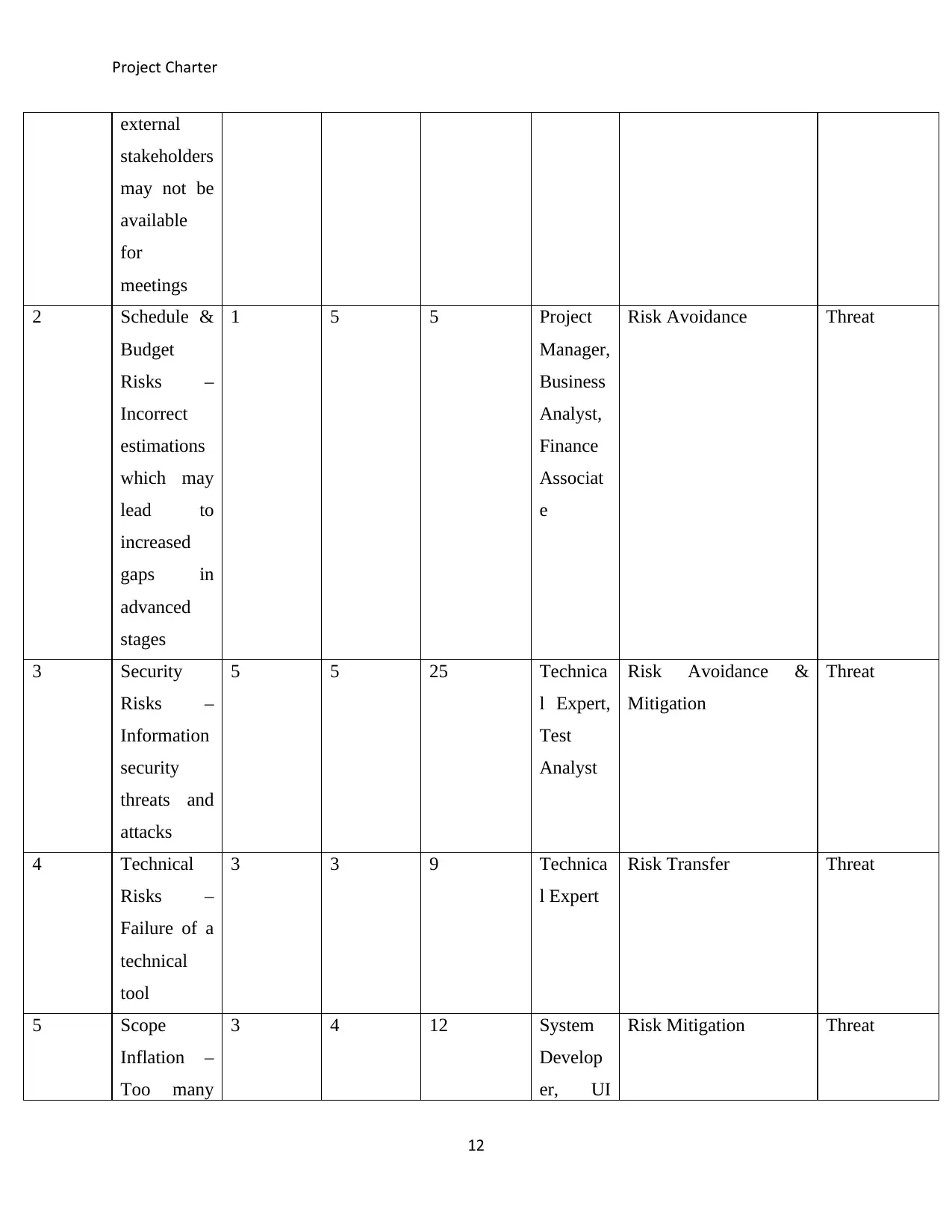
Project Charter
external
stakeholders
may not be
available
for
meetings
2 Schedule &
Budget
Risks –
Incorrect
estimations
which may
lead to
increased
gaps in
advanced
stages
1 5 5 Project
Manager,
Business
Analyst,
Finance
Associat
e
Risk Avoidance Threat
3 Security
Risks –
Information
security
threats and
attacks
5 5 25 Technica
l Expert,
Test
Analyst
Risk Avoidance &
Mitigation
Threat
4 Technical
Risks –
Failure of a
technical
tool
3 3 9 Technica
l Expert
Risk Transfer Threat
5 Scope
Inflation –
Too many
3 4 12 System
Develop
er, UI
Risk Mitigation Threat
12
external
stakeholders
may not be
available
for
meetings
2 Schedule &
Budget
Risks –
Incorrect
estimations
which may
lead to
increased
gaps in
advanced
stages
1 5 5 Project
Manager,
Business
Analyst,
Finance
Associat
e
Risk Avoidance Threat
3 Security
Risks –
Information
security
threats and
attacks
5 5 25 Technica
l Expert,
Test
Analyst
Risk Avoidance &
Mitigation
Threat
4 Technical
Risks –
Failure of a
technical
tool
3 3 9 Technica
l Expert
Risk Transfer Threat
5 Scope
Inflation –
Too many
3 4 12 System
Develop
er, UI
Risk Mitigation Threat
12
Paraphrase This Document
Need a fresh take? Get an instant paraphrase of this document with our AI Paraphraser
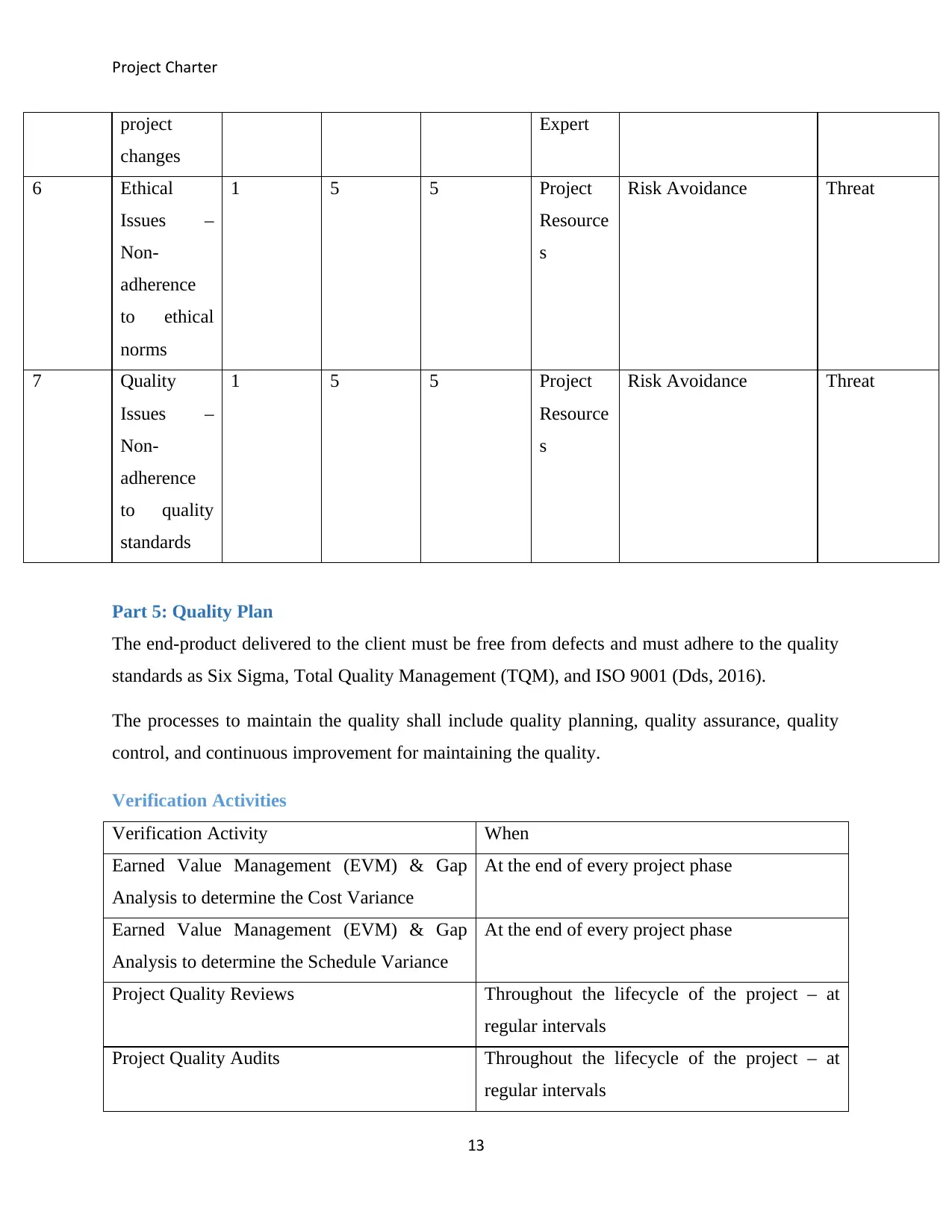
Project Charter
project
changes
Expert
6 Ethical
Issues –
Non-
adherence
to ethical
norms
1 5 5 Project
Resource
s
Risk Avoidance Threat
7 Quality
Issues –
Non-
adherence
to quality
standards
1 5 5 Project
Resource
s
Risk Avoidance Threat
Part 5: Quality Plan
The end-product delivered to the client must be free from defects and must adhere to the quality
standards as Six Sigma, Total Quality Management (TQM), and ISO 9001 (Dds, 2016).
The processes to maintain the quality shall include quality planning, quality assurance, quality
control, and continuous improvement for maintaining the quality.
Verification Activities
Verification Activity When
Earned Value Management (EVM) & Gap
Analysis to determine the Cost Variance
At the end of every project phase
Earned Value Management (EVM) & Gap
Analysis to determine the Schedule Variance
At the end of every project phase
Project Quality Reviews Throughout the lifecycle of the project – at
regular intervals
Project Quality Audits Throughout the lifecycle of the project – at
regular intervals
13
project
changes
Expert
6 Ethical
Issues –
Non-
adherence
to ethical
norms
1 5 5 Project
Resource
s
Risk Avoidance Threat
7 Quality
Issues –
Non-
adherence
to quality
standards
1 5 5 Project
Resource
s
Risk Avoidance Threat
Part 5: Quality Plan
The end-product delivered to the client must be free from defects and must adhere to the quality
standards as Six Sigma, Total Quality Management (TQM), and ISO 9001 (Dds, 2016).
The processes to maintain the quality shall include quality planning, quality assurance, quality
control, and continuous improvement for maintaining the quality.
Verification Activities
Verification Activity When
Earned Value Management (EVM) & Gap
Analysis to determine the Cost Variance
At the end of every project phase
Earned Value Management (EVM) & Gap
Analysis to determine the Schedule Variance
At the end of every project phase
Project Quality Reviews Throughout the lifecycle of the project – at
regular intervals
Project Quality Audits Throughout the lifecycle of the project – at
regular intervals
13
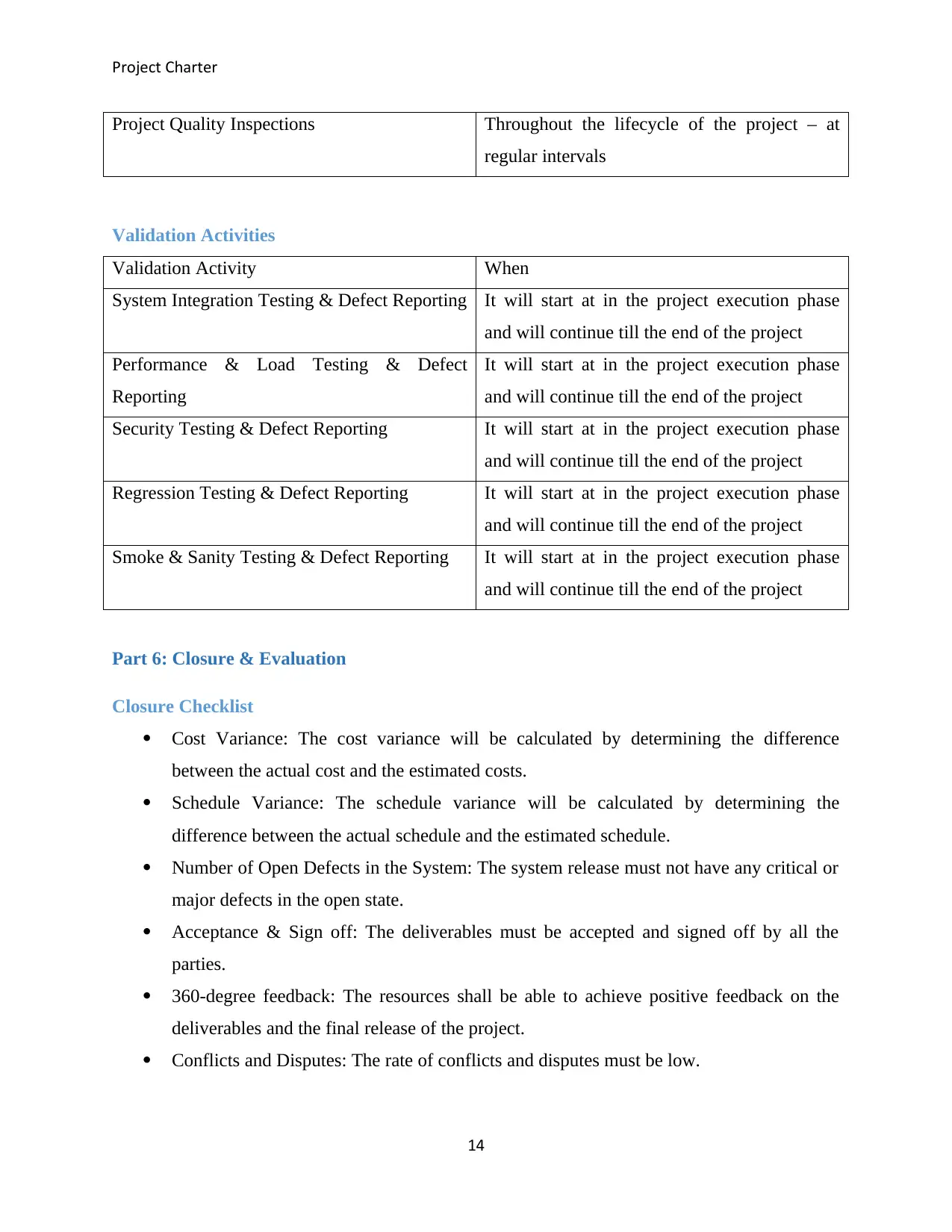
Project Charter
Project Quality Inspections Throughout the lifecycle of the project – at
regular intervals
Validation Activities
Validation Activity When
System Integration Testing & Defect Reporting It will start at in the project execution phase
and will continue till the end of the project
Performance & Load Testing & Defect
Reporting
It will start at in the project execution phase
and will continue till the end of the project
Security Testing & Defect Reporting It will start at in the project execution phase
and will continue till the end of the project
Regression Testing & Defect Reporting It will start at in the project execution phase
and will continue till the end of the project
Smoke & Sanity Testing & Defect Reporting It will start at in the project execution phase
and will continue till the end of the project
Part 6: Closure & Evaluation
Closure Checklist
Cost Variance: The cost variance will be calculated by determining the difference
between the actual cost and the estimated costs.
Schedule Variance: The schedule variance will be calculated by determining the
difference between the actual schedule and the estimated schedule.
Number of Open Defects in the System: The system release must not have any critical or
major defects in the open state.
Acceptance & Sign off: The deliverables must be accepted and signed off by all the
parties.
360-degree feedback: The resources shall be able to achieve positive feedback on the
deliverables and the final release of the project.
Conflicts and Disputes: The rate of conflicts and disputes must be low.
14
Project Quality Inspections Throughout the lifecycle of the project – at
regular intervals
Validation Activities
Validation Activity When
System Integration Testing & Defect Reporting It will start at in the project execution phase
and will continue till the end of the project
Performance & Load Testing & Defect
Reporting
It will start at in the project execution phase
and will continue till the end of the project
Security Testing & Defect Reporting It will start at in the project execution phase
and will continue till the end of the project
Regression Testing & Defect Reporting It will start at in the project execution phase
and will continue till the end of the project
Smoke & Sanity Testing & Defect Reporting It will start at in the project execution phase
and will continue till the end of the project
Part 6: Closure & Evaluation
Closure Checklist
Cost Variance: The cost variance will be calculated by determining the difference
between the actual cost and the estimated costs.
Schedule Variance: The schedule variance will be calculated by determining the
difference between the actual schedule and the estimated schedule.
Number of Open Defects in the System: The system release must not have any critical or
major defects in the open state.
Acceptance & Sign off: The deliverables must be accepted and signed off by all the
parties.
360-degree feedback: The resources shall be able to achieve positive feedback on the
deliverables and the final release of the project.
Conflicts and Disputes: The rate of conflicts and disputes must be low.
14
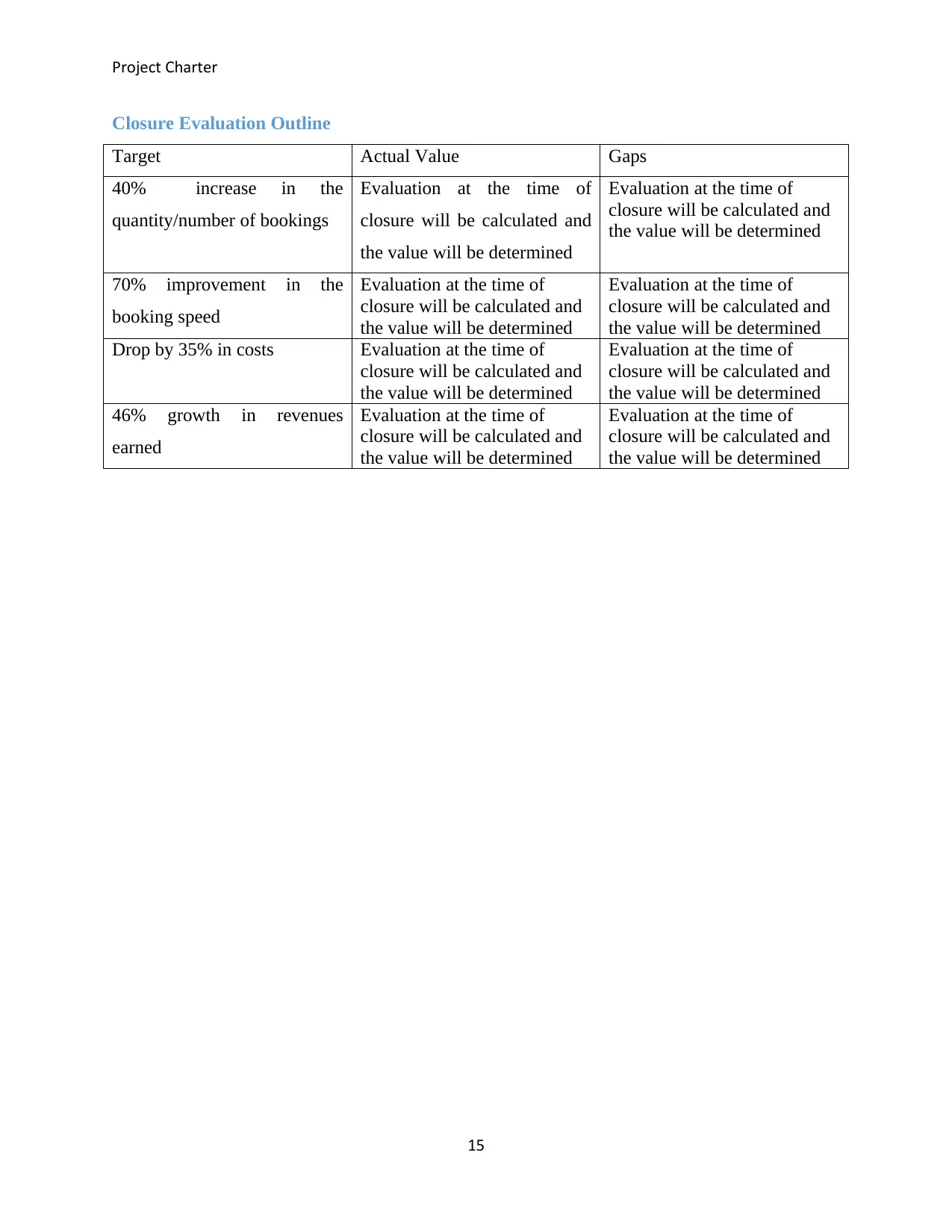
Project Charter
Closure Evaluation Outline
Target Actual Value Gaps
40% increase in the
quantity/number of bookings
Evaluation at the time of
closure will be calculated and
the value will be determined
Evaluation at the time of
closure will be calculated and
the value will be determined
70% improvement in the
booking speed
Evaluation at the time of
closure will be calculated and
the value will be determined
Evaluation at the time of
closure will be calculated and
the value will be determined
Drop by 35% in costs Evaluation at the time of
closure will be calculated and
the value will be determined
Evaluation at the time of
closure will be calculated and
the value will be determined
46% growth in revenues
earned
Evaluation at the time of
closure will be calculated and
the value will be determined
Evaluation at the time of
closure will be calculated and
the value will be determined
15
Closure Evaluation Outline
Target Actual Value Gaps
40% increase in the
quantity/number of bookings
Evaluation at the time of
closure will be calculated and
the value will be determined
Evaluation at the time of
closure will be calculated and
the value will be determined
70% improvement in the
booking speed
Evaluation at the time of
closure will be calculated and
the value will be determined
Evaluation at the time of
closure will be calculated and
the value will be determined
Drop by 35% in costs Evaluation at the time of
closure will be calculated and
the value will be determined
Evaluation at the time of
closure will be calculated and
the value will be determined
46% growth in revenues
earned
Evaluation at the time of
closure will be calculated and
the value will be determined
Evaluation at the time of
closure will be calculated and
the value will be determined
15
Secure Best Marks with AI Grader
Need help grading? Try our AI Grader for instant feedback on your assignments.
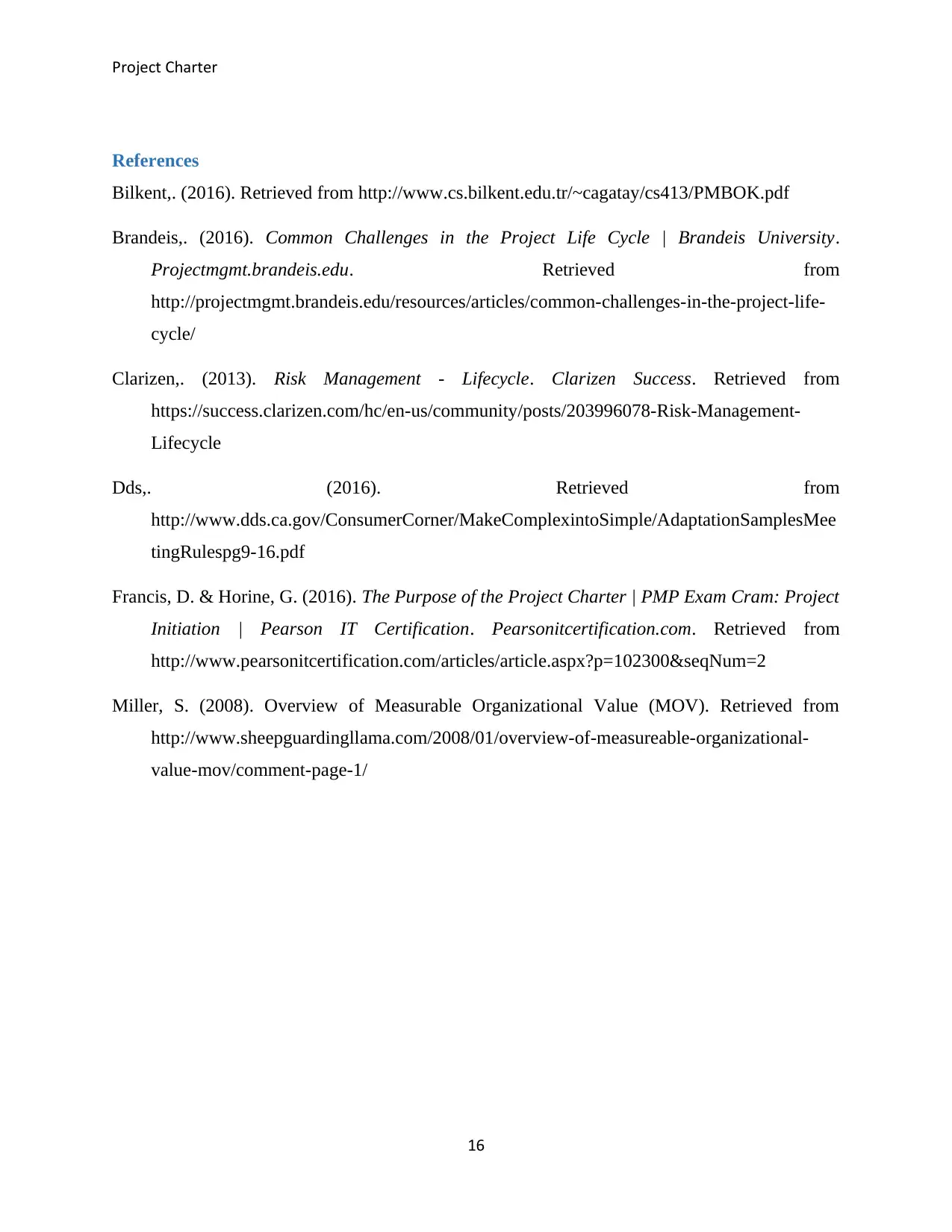
Project Charter
References
Bilkent,. (2016). Retrieved from http://www.cs.bilkent.edu.tr/~cagatay/cs413/PMBOK.pdf
Brandeis,. (2016). Common Challenges in the Project Life Cycle | Brandeis University.
Projectmgmt.brandeis.edu. Retrieved from
http://projectmgmt.brandeis.edu/resources/articles/common-challenges-in-the-project-life-
cycle/
Clarizen,. (2013). Risk Management - Lifecycle. Clarizen Success. Retrieved from
https://success.clarizen.com/hc/en-us/community/posts/203996078-Risk-Management-
Lifecycle
Dds,. (2016). Retrieved from
http://www.dds.ca.gov/ConsumerCorner/MakeComplexintoSimple/AdaptationSamplesMee
tingRulespg9-16.pdf
Francis, D. & Horine, G. (2016). The Purpose of the Project Charter | PMP Exam Cram: Project
Initiation | Pearson IT Certification. Pearsonitcertification.com. Retrieved from
http://www.pearsonitcertification.com/articles/article.aspx?p=102300&seqNum=2
Miller, S. (2008). Overview of Measurable Organizational Value (MOV). Retrieved from
http://www.sheepguardingllama.com/2008/01/overview-of-measureable-organizational-
value-mov/comment-page-1/
16
References
Bilkent,. (2016). Retrieved from http://www.cs.bilkent.edu.tr/~cagatay/cs413/PMBOK.pdf
Brandeis,. (2016). Common Challenges in the Project Life Cycle | Brandeis University.
Projectmgmt.brandeis.edu. Retrieved from
http://projectmgmt.brandeis.edu/resources/articles/common-challenges-in-the-project-life-
cycle/
Clarizen,. (2013). Risk Management - Lifecycle. Clarizen Success. Retrieved from
https://success.clarizen.com/hc/en-us/community/posts/203996078-Risk-Management-
Lifecycle
Dds,. (2016). Retrieved from
http://www.dds.ca.gov/ConsumerCorner/MakeComplexintoSimple/AdaptationSamplesMee
tingRulespg9-16.pdf
Francis, D. & Horine, G. (2016). The Purpose of the Project Charter | PMP Exam Cram: Project
Initiation | Pearson IT Certification. Pearsonitcertification.com. Retrieved from
http://www.pearsonitcertification.com/articles/article.aspx?p=102300&seqNum=2
Miller, S. (2008). Overview of Measurable Organizational Value (MOV). Retrieved from
http://www.sheepguardingllama.com/2008/01/overview-of-measureable-organizational-
value-mov/comment-page-1/
16
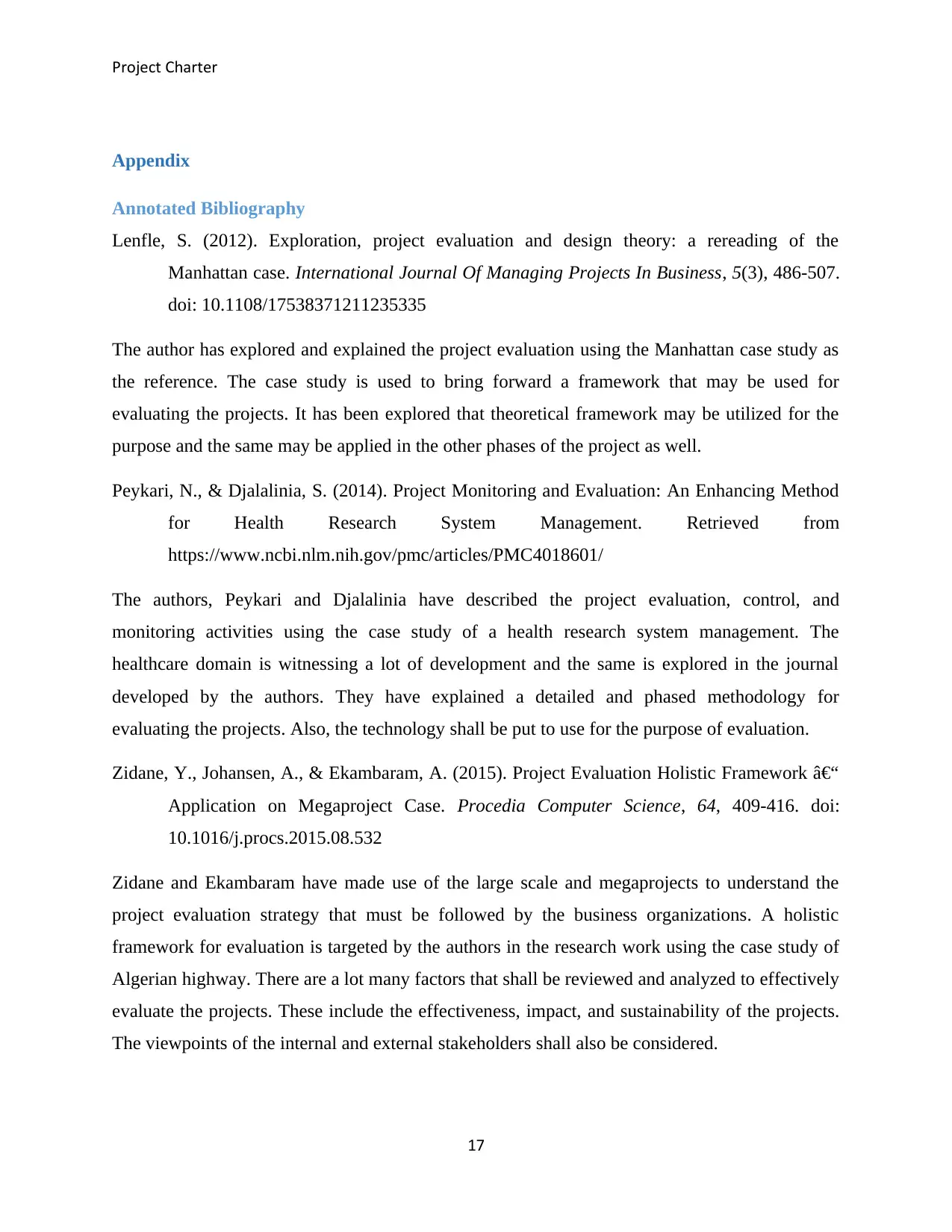
Project Charter
Appendix
Annotated Bibliography
Lenfle, S. (2012). Exploration, project evaluation and design theory: a rereading of the
Manhattan case. International Journal Of Managing Projects In Business, 5(3), 486-507.
doi: 10.1108/17538371211235335
The author has explored and explained the project evaluation using the Manhattan case study as
the reference. The case study is used to bring forward a framework that may be used for
evaluating the projects. It has been explored that theoretical framework may be utilized for the
purpose and the same may be applied in the other phases of the project as well.
Peykari, N., & Djalalinia, S. (2014). Project Monitoring and Evaluation: An Enhancing Method
for Health Research System Management. Retrieved from
https://www.ncbi.nlm.nih.gov/pmc/articles/PMC4018601/
The authors, Peykari and Djalalinia have described the project evaluation, control, and
monitoring activities using the case study of a health research system management. The
healthcare domain is witnessing a lot of development and the same is explored in the journal
developed by the authors. They have explained a detailed and phased methodology for
evaluating the projects. Also, the technology shall be put to use for the purpose of evaluation.
Zidane, Y., Johansen, A., & Ekambaram, A. (2015). Project Evaluation Holistic Framework –
Application on Megaproject Case. Procedia Computer Science, 64, 409-416. doi:
10.1016/j.procs.2015.08.532
Zidane and Ekambaram have made use of the large scale and megaprojects to understand the
project evaluation strategy that must be followed by the business organizations. A holistic
framework for evaluation is targeted by the authors in the research work using the case study of
Algerian highway. There are a lot many factors that shall be reviewed and analyzed to effectively
evaluate the projects. These include the effectiveness, impact, and sustainability of the projects.
The viewpoints of the internal and external stakeholders shall also be considered.
17
Appendix
Annotated Bibliography
Lenfle, S. (2012). Exploration, project evaluation and design theory: a rereading of the
Manhattan case. International Journal Of Managing Projects In Business, 5(3), 486-507.
doi: 10.1108/17538371211235335
The author has explored and explained the project evaluation using the Manhattan case study as
the reference. The case study is used to bring forward a framework that may be used for
evaluating the projects. It has been explored that theoretical framework may be utilized for the
purpose and the same may be applied in the other phases of the project as well.
Peykari, N., & Djalalinia, S. (2014). Project Monitoring and Evaluation: An Enhancing Method
for Health Research System Management. Retrieved from
https://www.ncbi.nlm.nih.gov/pmc/articles/PMC4018601/
The authors, Peykari and Djalalinia have described the project evaluation, control, and
monitoring activities using the case study of a health research system management. The
healthcare domain is witnessing a lot of development and the same is explored in the journal
developed by the authors. They have explained a detailed and phased methodology for
evaluating the projects. Also, the technology shall be put to use for the purpose of evaluation.
Zidane, Y., Johansen, A., & Ekambaram, A. (2015). Project Evaluation Holistic Framework –
Application on Megaproject Case. Procedia Computer Science, 64, 409-416. doi:
10.1016/j.procs.2015.08.532
Zidane and Ekambaram have made use of the large scale and megaprojects to understand the
project evaluation strategy that must be followed by the business organizations. A holistic
framework for evaluation is targeted by the authors in the research work using the case study of
Algerian highway. There are a lot many factors that shall be reviewed and analyzed to effectively
evaluate the projects. These include the effectiveness, impact, and sustainability of the projects.
The viewpoints of the internal and external stakeholders shall also be considered.
17
1 out of 18
Related Documents
Your All-in-One AI-Powered Toolkit for Academic Success.
+13062052269
info@desklib.com
Available 24*7 on WhatsApp / Email
![[object Object]](/_next/static/media/star-bottom.7253800d.svg)
Unlock your academic potential
© 2024 | Zucol Services PVT LTD | All rights reserved.




